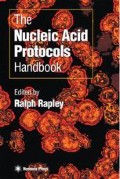Abstract
Nonradioactive oligonucleotide probes are increasingly being used in various applications, for example, polymerase chain reaction (PCR) product detection, in situ hybridization and colony and plaque screening (1). Oligonucleotide probes are short, defined sequences, 15–50 bases long, that are relatively easy to produce. As the base composition of oligonucleotide probes dictates the hybridization properties (2), probes can be designed to discriminate between perfectly matched and mismatched target sequences.
Access this chapter
Tax calculation will be finalised at checkout
Purchases are for personal use only
Notes
- 1.
*
Succinimidyl 4-(N-maleimidomethyl) cyclohexane-1-carbonate
References
Keller, G. H. and Manak, M. M. (1989) Hybridization formats and detection procedures, in DNA Probes. Stockton, NY, pp. 149–214.
Thein, S. L. and Wallace, R. B. (1986) The use of synthetic oligonucleotides as specific hybridization probes in the diagnosis of genetic disorders, in Human Genetic Disease: A Practical Approach (Davies, K. E., ed.), IRL, Oxford, pp. 33–50.
Misiura, K., Durrant, I., Evans, M. R., and Gait, M. J. (1990) Biotinyl and phospho-tyrosinyl phosphoramidite derivatives useful in the incorporation of multiple reporter groups on synthetic oligonucleotides. Nucleic Acids Res. 18, 4345–4354.
Connoly, B. A. and Rider, P. (1985) Chemical synthesis of oligonucleotides containing a free sulphydryl group and subsequent attachment of thiol specific probes. Nucleic Acids Res. 13, 4485–4502.
Connolly, B. A. (1987) The synthesis of oligonucleotides containing a primary amino group at the 5′ terminus. Nucleic Acids Res. 15, 3131–3139.
Murakami, A., Tada, J., Yamagata, K., and Takano, J. (1989) Highly sensitive detection of DNA using enzyme-linked DNA probe. 1. Colourimetric and fluorometric detection. Nucleic Acids Res. 17, 5587–5595.
Fowler, S. J., Harding, E. R., and Evans, M. R. (1990) Labeling of oligonucleotide with horseradish peroxidase and detection using enhanced chemiluminescence. Technique 2, 261–267.
Durrant, I. (1991) Stringency control with 3′-tailed oligonucleotide probes. Highlights 2, 6–7.
Sambrook, J., Fritsch, E. F., and Maniatis, T. (1982) Spun column procedures, in Molecular Cloning: A Laboratory Manual, Cold Spring Harbor Laboratory, Cold Spring Harbor, NY, pp. 466–467.
Pollard-Knight, D. (1990) Current methods in nonradioactive nucleic acid labelling and detection. Technique 2, 113–132.
Durrant, I. (1990) Light based detection of biomolecules. Nature (London) 346, 297–298.
Wallace, R. B. and Miyada, C. G. (1990) Oligonucleotide probes. Methods Enzymol. 152, 438.
Wallace, R. B., Shaffer, J., Murphy, R. F., Bonner, J., Hirose, T., and Itakura, K. (1979) Hybridization of synthetic oligodeoxyribonucleotides to φX174: the effect of single base pair mismatch. Nucleic Acids Res. 6, 3543–3356.
Thorpe, G. H. G. and Kricka, L. J. (1987) Enhanced chemiluminescent assays for horseradish peroxidase: characteristics and applications, in Bioluminescence and Chemiluminescence: New Perspectives (Scholmerich, J., Andreesen, R., Kapp, A., Ernst, M., and Woods, W. G., eds.), Wiley, NY, pp. 199–208.
Cunningham, M. (1991) Nucleic acid detection with light. Life Set News 6, 2–5.
Author information
Authors and Affiliations
Editor information
Editors and Affiliations
Rights and permissions
Copyright information
© 2000 Humana Press Inc., Totowa, NJ
About this protocol
Cite this protocol
Fowler, S., Durrant, I. (2000). Nonradioactive Oligonucleotide Probe Labeling. In: Rapley, R. (eds) The Nucleic Acid Protocols Handbook. Springer Protocols Handbooks. Humana Press, Totowa, NJ. https://doi.org/10.1385/1-59259-038-1:135
Download citation
DOI: https://doi.org/10.1385/1-59259-038-1:135
Publisher Name: Humana Press, Totowa, NJ
Print ISBN: 978-0-89603-459-4
Online ISBN: 978-1-59259-038-4
eBook Packages: Springer Book Archive

